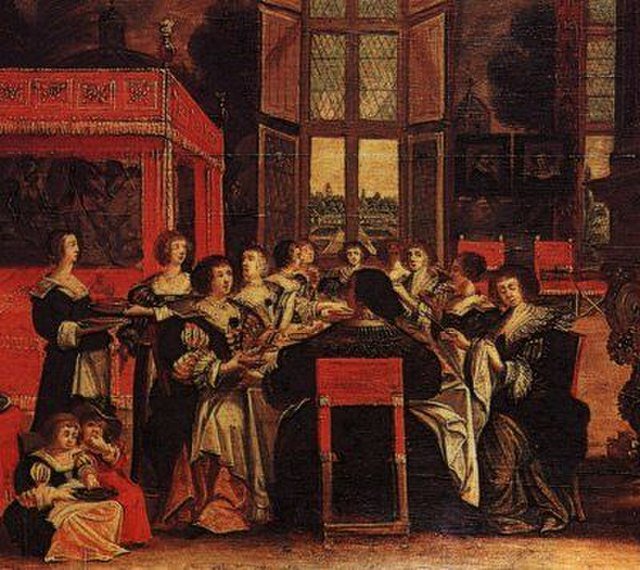Inside the Literary Salon I: the Female Voice of the French Renaissance
A typical female-run French literary salon (Image credit: Wikimedia Commons)
In “Inside the Literary Salon”, Martha Leggett’s series of columns will examine the impact of the salon and, namely, female-only salons, on French literary culture, and maps their trajectories from female-only spaces to mixed spaces which were still run by women. Although accorded an important place in literary history for their promotion of female voices, “single-sex” spaces have since become controversial in contemporary France; in the face of this, Martha thus seeks to interrogate whether exclusive activism such as that practised in historic female-only salons is still useful in a contemporary context, and to question the place of literary salons in French literary culture today.
Salons, physical and intellectual spaces dedicated to discussion in the hopes of harnessing discussion. Oftentimes regulated by a host, I’m thinking of Gertrude Stein and her Parisian apartment full to the brim with artists and writers. In Antiquity, then an Academy, it would have been Aristotle and Plato deciding the topic of discussion; Raphael’s fresco The School of Athens perhaps captures this best. It is the identity of the host then, that is of significance. Salons run by women, Salonnières, even more important, giving recognition to female voices and issues pertinent to them.
We might think of a salon as a large amount of upper middle class people eating a caviar amuse-bouche. But I invite you to imagine a room full of people with a roasting fire, decadent chairs, paintings covering the walls, music playing and other entertainment. This obviously is not what all salon’s resembled, but it is my favourite version. A topic has been discussed prior, by the host, and famous names from the city, and beyond, come together to debate their side, or to discuss in further detail, the proposed question.
Female-run salons began long before the likes of Stein, with the early Renaissance being their ‘birthplace.’ The Italian noblewomen Isabella D’Este and Elisabetta Gonzaga, in the early 16th century, are among the first women to be credited for their illustrious salon, even making it into Castiglione’s Il Corteggiano for their prestige and influence. The salon, just like Petrarch and Boccacio, quickly made its way to France. Lyon in this case, with women like Louise Labé creating her own famous salon. Just a quick Wikipedia search of French salon owners will unveil countless female powerhouses, Marguerite de Navarre being one notable name.
But why Lyon? Paris is much more metropolitan and the city was home to some of the most important salons in the 17th century. I’m thinking particularly about Hôtel de Rambouillet, a 28 year old ? salon. Yet, Lyon is important because of its identity as another literary and cultural hub during the renaissance. This is mainly thanks to its physical location, neatly placed in a junction between two rivers, the Rhône and the Saône, meaning many trade routes passed through Lyon. Trade throughout Lyon would most certainly have included metal; the key to making the printing press. Printing, thereafter, was practiced more and more in Lyonnais life, allowing literature to be published and circulated.
Jean de Tournes is the exemplification of this cross-over, the son of a metal worker who branched out into printing and is regarded as the most important printer in mid-16th century Lyon. Of course, literary works were still not particularly accessible, with Europe having around an 11% literacy rate, meaning that distribution was mainly limited to the upper classes. However, women like Louise Labé, the daughter of a ropemaker, would have had access to some of this literature. Subsequently, with access to literature, poetic schools and humanist learning became more current in Lyonnais society.
Women were a key part of this literary rebirth. Ironically, one of the crucial figures of female Renaissance writers was not from Modern France, but Ancient Greece: Sappho. She is first evoked in Ovid as a figure of legend living on Lesbos, a female-only island. Her works were re-discovered during the Renaissance, and her poetic identity was renewed. Renaissance poets like Louise Labé had found their inspiration, a female poet, spreading across centuries, who gave them the occasion to write and be heard.
Louise Labé capitalised from this in her Sonnets and her proto-feminist manifesto, À Mademoiselle de Clémence de Bourges Lyonnaise. This dedication to de Bourges is before it’s time, a description of a female evolution that is happening, founded in the present. In a particularly poignant moment, she discusses that the prowess of female poets is so great that if women start to pick up the pen men will
be forced to write to a higher quality to match them: a goal she achieved with her salon, a space for women to praise each other, and work together, in order to make praiseworthy poetry.
You may be interested in Labé’s literary works, and if so, her Sonnet 19 is particularly interesting. Briefly, a woman comes across Diana, the roman goddess of hunting and virginity, being dressed by her nymphs. There is a lovely meta-textual link in that Ovid writes of the myth of Diana and Acteon, as he does of Sappho, and so in writing this sonnet, Labé solidifies the two women together, emphasising her need to have a female space.
If this has quenched your thirst for more on the literary salon, in the following columns we will look at female run spaces in modern day France, whether that be the MLF (Mouvement de Libération des Femmes) a single-sex feminist movement, not that unlike Labé’s desire for a female only space, or women like Gertrude Stein, and those that followed her, and how female voices continue to be nourished by Salons.
